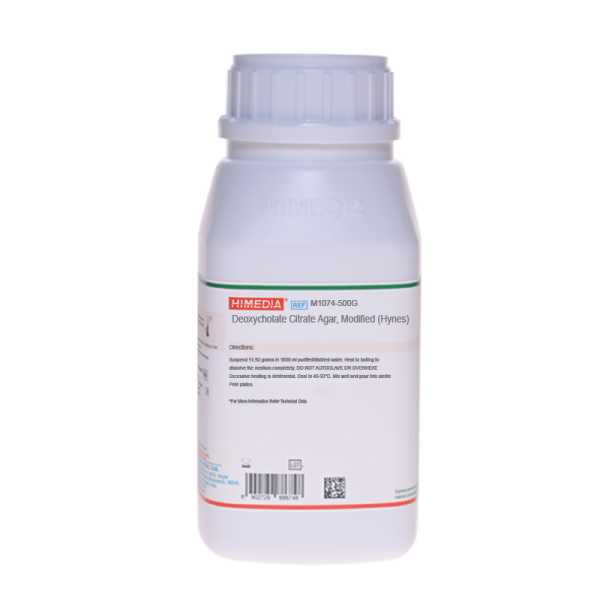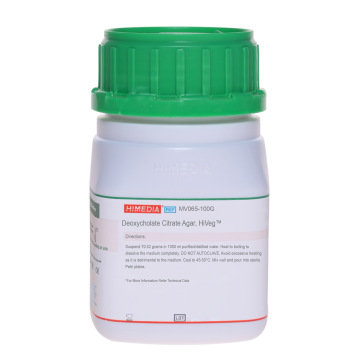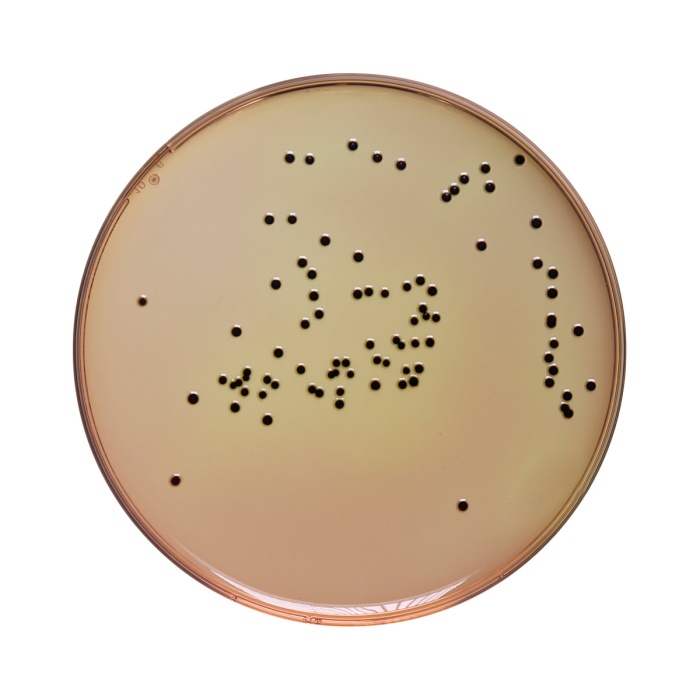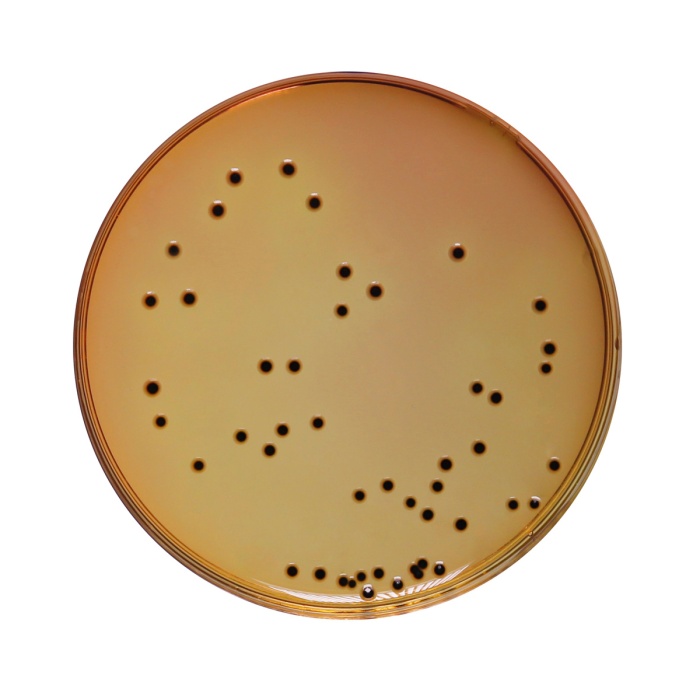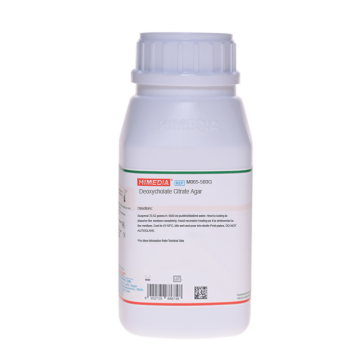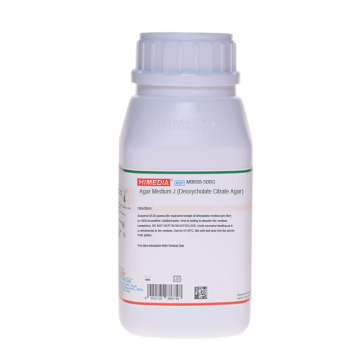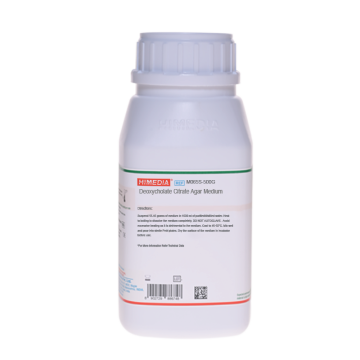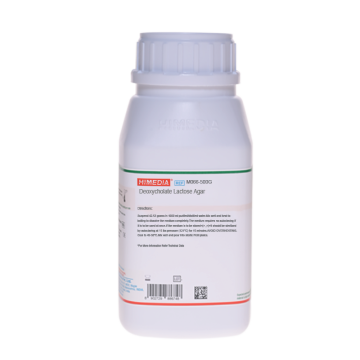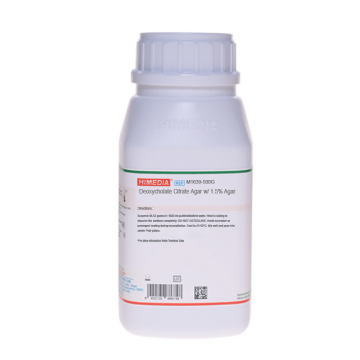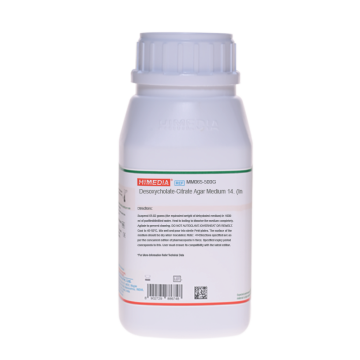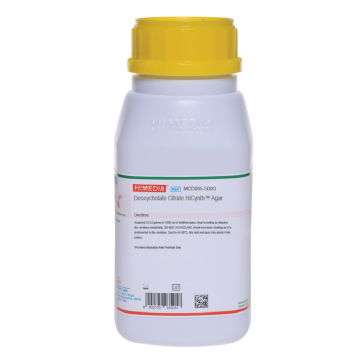 Your enquiry has been submitted
Your enquiry has been submitted
Deoxycholate Citrate Agar, Modified (Hynes)
Intended Use:
Recommended selective medium for the isolation of Salmonella and Shigella species.
Composition**
| Ingredients | Gms / Litre |
|---|---|
| Peptone | 5.000 |
| HM peptone# | 5.000 |
| Lactose | 10.000 |
| Sodium citrate | 8.500 |
| Ferric citrate | 1.000 |
| Sodium deoxycholate | 5.000 |
| Sodium thiosulphate | 5.400 |
| Neutral red | 0.020 |
| Agar | 12.000 |
Final pH (at 25°C) 7.3±0.2
**Formula adjusted, standardized to suit performance parameters
#- Equivalent to Beef extract
Directions
Suspend 51.92 grams in 1000 ml purified / distilled water. Heat to boiling to dissolve the medium completely. DO NOT AUTOCLAVE OR OVERHEAT. Excessive heating is detrimental.
Principle And Interpretation
Deoxycholate Citrate Agar, Modified (Hynes) is a selective medium used for isolation and identification of Salmonellae and Shigallae. Leifson (4) developed Deoxycholate Agar as a differential medium containing pure chemicals, citrates and deoxycholate as inhibitors. Leifsons medium has been modified by many authors by several ways. Deoxycholate Citrate Agar, Modified (Hynes) is a differential medium modified by Hynes (1) for the isolation of Salmonellae and Shigellae. Deoxycholate Citrate Agar, Modified consist of more concentrations of inhibitors and is used in food microbiology (6). Peptone and HM peptone provides carbon, nitrogen, long chain amino acids, vitamins and minerals. Coliform bacteria and gram-positive bacteria are inhibited or greatly suppressed due to sodium deoxycholate, sodium citrate and ferric citrate. Lactose helps in differentiating enteric bacilli, as lactose fermenters produce red colonies while lactose non-fermenters produce colourless colonies. Coliform bacteria, if present form pink colonies on this medium. The degradation of lactose causes acidification of the medium surrounding the relevant colonies causing the pH indicator neutral red to change its colour to red. These colonies usually are also surrounded by a turbid zone of precipitated deoxycholic acid due to acidification of the medium. Sodium deoxycholate combines with neutral red in an acidic environment, causing the dye to go out of the solution with the subsequent precipitation of deoxycholate (4). The reduction of sodium thiosulphate to sulfide is indicated by the formation of black iron sulfide. Salmonella and Shigella species do not ferment lactose but Salmonella may produce H2S forming colorless colonies with or without black centers. Citrate and iron (Fe) combination has a strong hydrolyzing effect on agar when the medium is heated, producing a soft and unelastic agar. If autoclaved the agar becomes soft and almost impossible to streak (4). Surface colonies of non-lactose fermenters often absorb a little colour (pinkish) from the medium and organisms may be mistaken for coliforms (4).
Type of specimen
Food samples
Specimen Collection and Handling:
For food samples, follow appropriate techniques for sample collection and processing as per guidelines (5).
After use, contaminated materials must be sterilized by autoclaving before discarding.
Warning and Precautions :
Read the label before opening the container. Wear protective gloves/protective clothing/eye protection/ face protection. Follow good microbiological lab practices while handling specimens and culture. Standard precautions as per established guidelines should be followed while handling specimens. Safety guidelines may be referred in individual safety data sheets.
Limitations :
- This medium is general purpose medium and may not support the growth of fastidious organisms.
- Avoid excessive heating as it is pernicious to the medium.
Performance and Evaluation
Performance of the medium is expected when used as per the direction on the label within the expiry period when stored at recommended temperature.
Quality Control
Appearance Light yellow to pinkish beige homogeneous free flowing powder
Gelling Firm, comparable with 1.2% Agar gel.
Colour and Clarity of prepared medium Reddish orange coloured, clear to slightly opalescent gel forms in Petri plates
Reaction Reaction of 5.19% w/v aqueous solution at 25°C. pH : 7.3±0.2
pH 7.10-7.50
Cultural Response
Cultural characteristics observed after an incubation at 35-37°C for 18-24 hours.
| Organism | Inoculum (CFU) | Growth | Recovery | Colour of Colony | H2S |
|---|---|---|---|---|---|
| Bacillus cereus ATCC 10876 | >=104 | inhibited | 0% | ||
| Escherichia coli ATCC 25922 (00013*) | 50-100 | poor-fair | 20-30% | red | negative reaction |
| Salmonella Enteritidis ATCC 13076 (00030*) | 50-100 | good-luxuriant | >=50% | colourless | positive reaction, black centered colonies |
| Salmonella Typhimurium ATCC 14028 (00031*) | 50-100 | good-luxuriant | >=50% | colourless | positive reaction, black centered colonies |
| Shigella flexneri ATCC 12022 (00126*) | 50-100 | good-luxuriant | >=50% | colourless | negative reaction |
| Klebsiella pneumoniae ATCC 13883 (00097*) | 50-100 | good-luxuriant | >=50% | light pink | negative reaction |
| Shigella sonnei ATCC 25931 | 50-100 | good-luxuriant | >=50% | pink with bile precipitate | negative reaction |
| Staphylococcus aureus subsp. aureus ATCC 25923 (00034*) | >=104 | inhibited | 0% |
Key : *Corresponding WDCM numbers.
Storage and Shelf Life
Store between 10-30°C in a tightly closed container and the prepared medium at 20-30°C. Use before expiry date on the label. On opening, product should be properly stored dry, after tightly capping the bottle in order to prevent lump formation due to the hygroscopic nature of the product. Improper storage of the product may lead to lump formation. Store in dry ventilated area protected from extremes of temperature and sources of ignition. Seal the container tightly after use. Use before expiry date on the label. Product performance is best if used within stated expiry period.
Disposal
User must ensure safe disposal by autoclaving and/or incineration of used or unusable preparations of this product. Follow established laboratory procedures in disposing of infectious materials and material that comes into contact with sample must be decontaminated and disposed of in accordance with current laboratory techniques (2,3).
Reference
- Hynes M., 1942, J. Path. Bacteriol., 54, 193-207.
- Isenberg, H.D. Clinical Microbiology Procedures Handbook 2nd Edition.
- Jorgensen, J.H., Pfaller, M.A., Carroll, K.C., Funke, G., Landry, M.L., Richter, S.S and Warnock., D.W. (2015) Manual of Clinical Microbiology, 11th Edition. Vol. 1.
- Leifson, 1935, J. Pathol. Bacteriol., 40:581.
- Salfinger Y., and Tortorello M.L. Fifth (Ed.), 2015, Compendium of Methods for the Microbiological Examination of Foods, 5th Ed., American Public Health Association, Washington, D.C.
- Speck M. (Ed.), 1984, Compendium of Methods for the Microbiological Examination of Foods, 2nd ed., APHA, Washington, D.C.
| Product Name | Deoxycholate Citrate Agar, Modified (Hynes) |
|---|---|
| SKU | M1074 |
| Product Type | Regular |
| Physical Form | Powder |
| Origin | Animal |
| Packaging type | HDPE |
| References | 1. Leifson, 1935, J. Pathol. Bacteriol., 40:581. |
| Customized Product Available | No |



